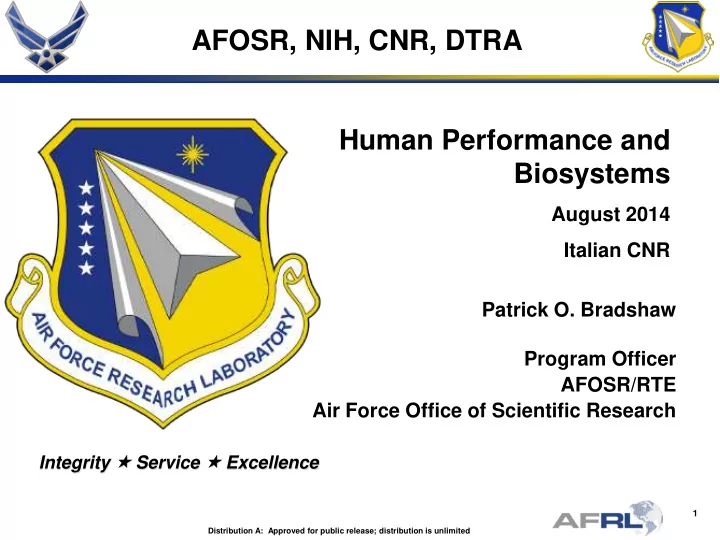

AFOSR, NIH, CNR, DTRA Human Performance and Biosystems August 2014 Italian CNR Patrick O. Bradshaw Program Officer AFOSR/RTE Air Force Office of Scientific Research Integrity Service Excellence 1 Distribution A: Approved for public release; distribution is unlimited
2014 Italian CNR Presentation BRIEF DESCRIPTION OF PORTFOLIO: • Auditory modeling for acoustic analysis • Biological polarization optics & vision • Sensori-motor control of bio- flight & navigation • Nanoelectronic innervated cells and networks • Biomarkers • Low volt stimulation of Neural systems 2
Human Performance and Biosystems Program • Investigates how the auditory brain parses acoustic landscapes, binds sensory inputs, adapts its filters, and hears through noise and distortion • Studies how animal photoreceptors detect and how their brains interpret polarization information • Discover principles of multisensory fusion, distributed sensors and actuators. Develop control laws for emulation in MAVs. • Develops a mechanistic understanding of microbes, nanowires, nanoelectronics and their energy delivery capabilities • Studies mechanisms following low volt electrical stimulation of neural systems and resulting biomarkers 3
A Speech Analysis Breakthrough FIRST TECHNIQUE TO APPLY COMPUTATIONAL AUDITORY SCENE ANALYSIS TO IMPROVE MONAURAL INTELLIGIBILITY Individual Speech Hearing Performance against Multitalker Babble Speech intelligibility improves markedly for normal-hearing ( NH ) listeners and for hearing- impaired ( HI ) listeners Unpublished data. Status Report 1, STTR Phase II Project: "An Auditory Scene Analysis Approach to Speech Segregation” Dr. DeLiang Wang, Ohio State University DISTRIBUTION A: Approved for public release; distribution is unlimited. 4
Discovered: Mechanism of Biological Non-Polarizing Reflectors Unique optical reflectors : Suppress polarization at all angles • Layers of guanine cytoplasm crystals are broadband birefringent. • No refractive index mismatch between crystal layers and the external medium. Silvery fish avoid the Fresnel effect • Each crystal optical axis aligns with its (loss of reflectivity, gain of long axis or orthogonal to its plane. polarization at Brewster’s angle): • Optical design could be exploited in They maintain polarization synthetic devices. camouflage in all directions • T. M. Jordan, J. C. Partridge & N.W. Roberts. Univ. of Bristol. • Nature Photonics 2012. DISTRIBUTION A: Approved for public release; distribution is unlimited. 5
Wings are Sensorimotor Surfaces • Discovering their Role in Flight Control BATS Find and study hair sensors on wings. Measure response to air flow. Map wing sensor circuits to cortex. Measure joint muscle activity during flight. What is controlled? Force or position? Discover role of intrinsic (non-joint) muscles. HAWKMOTHS Record from strain receptors during wing motion. Measure dynamics of response to mechanical inputs. Map neural signal from wing to flight motor. DISTRIBUTION A: Approved for public release; distribution is unlimited. 6
BIO-SENSING OF MAGNETIC FIELDS A NEW INITIATIVE AFOSR SENSORY INFORMATION SYSTEMS PROGRAM SCIENTIFIC CHALLENGE : Discover the receptor mechanism(s) for biological magnetic sensitivity, especially at field strengths comparable to the geomagnetic background. PM ADVISORY GROUP : Patrick Bradshaw, Tatjana Curcic , Hugh DeLong, Willard Larkin (retired, v.e.c.) DISTRIBUTION A: Approved for public release; distribution is unlimited. 7
Next Phase (2013): Control of Electron Exchange via Bacterial Nanowires at Hybrid Living-Synthetic Interfaces El-Naggar (USC) Physiological switch: Developed methodology to physiologically induce bacterial nanowires in microfluidic devices as shown here by switching to extracellular respiration conditions. Can we achieve a genetic switch? Can we “plug” cells directly to synthetic devices using this same methodology? Objective 1: Profile the underlying gene expression with time-dependent transcriptomic Objective 2: To direct and monitor the wiring of analyses (RNA-seq) during bacterial nanowire bacterial cells ( Shewanella oneidensis MR-1) to production. The knowledge gained may enable micro/nano scale electrodes in microfluidic devices, while measuring the redox activity of the future development of genetic switches for turning on/off/amplifying electron transfer. the cells. RNA-seq work in collaboration with Golbeck (Penn State) Long-term goal: Synthetic biology Long-term goal: Powering and approaches for interfacing to a transferring the synthetic device extracellular electron directly using cellular transport function metabolic activity naturally existing in microbes like Shewanella to other 8 cell types. Next-generation sequencing
Nanoelectronic Structures for Single Cell to Cell- Network Interfaces Goal: Create and incorporate nanodevice elements that enable powerful two-way communication with cells. Charles M. Lieber, Harvard University 10
Our Integrative Approach 3D Macroporous Nanoelectronic Scaffolds 3D nanoelctronic scaffolds matrix prepared from 2D structures that are fully released from substrate. 3D scaffolds can exceed thickness >>1mm and maintain all key feature on micron-to-nanometer scale similar to natural biological scaffolds 11
Transcranial Direct Current Stimulation tDCS Transcranial Direct Current Stimulation (tDCS) • Non-invasive, portable, well-tolerated neuromodulation. • Low-intensity (mA) current passed between scalp electrodes. • Investigated for cognitive neuroscience and neuropsychiatric treatment. Depression, pain, migraine, epilepsy, PTSD, schizophrenia,tinnitus, rehabiliation, TBI, attention, accelerated learning (reading, motor skills, threat detection), memory… ➢➢ Can a “simple” intervention modulate brain function? ➢➢ How is specificity of action achieved? DoD BAA-AFOSR-2012-001 “Cellular Mechanisms of Transcranial Direct Current Stimulation” 12
Hypothesis The biological pathways modulated by tDCS are responsible for its beneficial effects on cognitive performance. Purpose of study: Identify those pathways • Objective 1: Identify pathways recruited by single bout of tDCS. • Objective 2: Determine effects of repeated tDCS when coupled with training. 13
Early Success of tDCS – Intervention/Treatment for neurological Disorders: Parkinson’s, Psychiatric Disease & Stroke – Cognitive improvements reported in both Disease and Control Populations – Improved detection of Collision Paths – Increased Cerebral Oxygen Saturation – Improved Target Detection Andy McKinley, PhD - AFRL 14
Summary • Auditory modeling for acoustic analysis • Biological polarization optics & vision • Sensori-motor control of bio- flight & navigation • Nanoelectronic innervated cells and networks • Biomarkers • Low volt stimulation of Neural systems 15 Distribution A: Approved for public release; distribution is unlimited
Recommend
More recommend